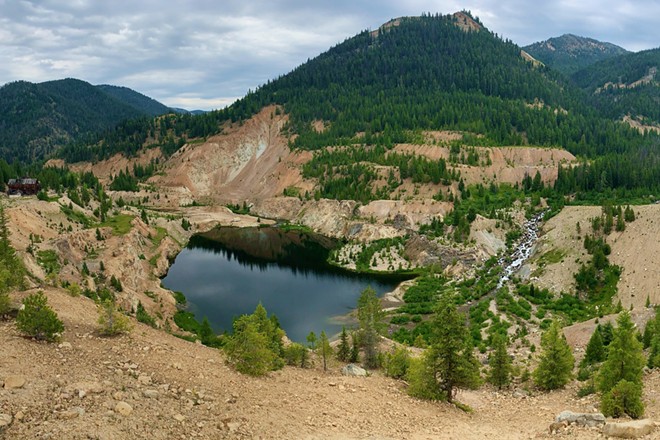Alongside its plans to reopen an abandoned 80-year-old mine containing gold, silver and antimony in central Idaho's Payette National Forest, Boise-based Perpetua Resources says it will also clean up and restore land and water at the heavily polluted Stibnite Gold Project.
The company's project would relocate part of the East Fork of the South Fork Salmon River, which for decades has been flowing through an abandoned mining pit.
But conservation groups warn that the company would divert the river through a concrete pipe so it can access the pit and mine it several hundred feet deeper. Tons of mine waste would ultimately be stored in a headwater streambed.
"Our vision from the start has been that if we were going to redevelop this abandoned mine site for gold and the critical mineral antimony, we would have to bring solutions for the environmental legacy features that were left behind by previous operators," says Mckinsey Lyon, a Perpetua spokesperson, by email.
In addition to rerouting the river, Lyon says, the company would repair "water quality that is degraded by millions of tons of legacy waste and tailings that were left on site. We fix these problems in the very first year of operations and continue to clean up legacy problems throughout the life of the mine."
If approved, the site east of McCall would become the only mined source of antimony in the U.S. Antimony is used to make bullets, batteries and flame retardants, and Perpetua received a $24.8 million critical minerals award from the Department of Defense in December to help with planning and permitting.
But some say the environmental risks outweigh the potential benefits of mining those resources.
"While the mining company is presenting this as a restoration project, with a great vision for what the landscape could look like when they're done, our review of the actual documents raises serious concerns of whether their activities are really going to ever restore the site," says John Robison, public lands director with the Idaho Conservation League. "It looks like mining is just going to make things worse."
The Salmon River ultimately becomes the Snake River, which flows into Washington and joins the Columbia River. Multiple threatened species of migratory fish live in those waterways.
"What makes the project so complex is the size and scope of it, and the sensitive nature of the habitat and what lies downstream," says Nick Kunath, conservation program manager for Idaho Rivers United. "I don't think a mine on this site will ever make sense."
The proposal has undergone several changes since it first filed for federal approval in 2016. On Jan. 10, the U.S. Forest Service closed a public comment period on the most recent study of environmental impacts that could result from the company's plan.
The Forest Service received more than 15,000 comments in support of Perpetua's efforts, with some applauding job creation and the potential to reduce reliance on other countries.
More than 3,000 comments were submitted against the proposal.
The Environmental Protection Agency identified several deficiencies in the study and called on the Forest Service to further consider air, water and land impacts.
In a Jan. 5 letter, the Nez Perce Tribe said they are "outraged" that the Forest Service picked Perpetua's modified mine plan as the preferred alternative, despite the Tribe's treaty rights that require protection of fishing, hunting and cultural resources.
"The Forest [Service] remains stubbornly resistant to embracing its legal duty to the Tribe because it will require denying Perpetua authorization to proceed with its project," Nez Perce Chairman Samuel Penney says in the letter. "The Forest [Service] lacks authority to violate the Tribe's treaty rights and must deny the project."
The Forest Service will spend several months considering the comments and working on a final environmental impact statement before making its final decision. ♦


























